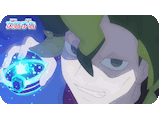
Feature



Main
Old Updates Archive
Links
 |
Lists |
List of Pokémon
Pokémon World Atlas
List of Techniques
List
of Items
List of TV Episodes
 |
Guides |
Episode
Comparisons
Movies
& Specials Guide
CD Guide
DVD Guide
Voice
Actors Guide
Lyrics Archive
Manga Guide
Video Games
 |
Miscellaneous |
Humor
Pokemon Bashing
Features
Rants
Dogasu's
Backpack
| Movies & Specials Guide | Mewtwo
Strikes Back Evolution
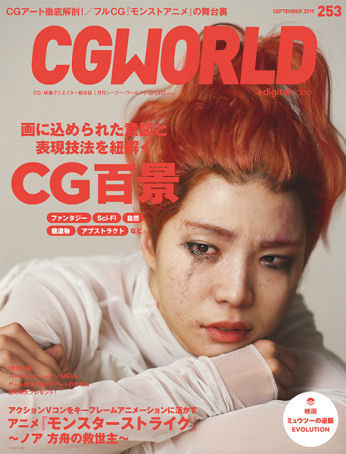
The September 2019 issue (No. 253) of the magazine CGWORLD had a 10-page feature on the making of the movie Mewtwo Strikes Back Evolution. CGWORLD is aimed at aspiring CG artists as well as people already in the field and therefore does not hold back when it comes to providing detailed explanations and using technical jargon.
A few weeks later CGWORLD released a supplemental article online that was aimed more at beginners. This second article was translated by Pocketmonsters.net. The online version recycles a lot of the same content from the print magazine but doesn't include everything.
This page takes a look at the print version of the feature. I don't have time to translate a 10-page article filled with technical explanations at the moment so I will instead provide summaries of the points I felt stood out the most.
Production on Mewtwo Strikes Back Evolution lasted about two and a half years; work on the film started in early 2017 with the creation of a pilot movie and wrapped up by the end of June 2019. The film debuted in the U.S. on July 4th, 2019.
It seems that one of director Kunihiko Yuyama's mantras for this film, at least based on how many times this is brought up in the feature, was to strive to do things with this remake that can't be done with traditionally hand-drawn animation. They didn't want to just do the same movie from 1998, but in CG; they wanted to upgrade scenes whenever possible.
As you're probably aware of by now this film had two directors: Kunihiko Yuyama and Motonori Sakakibara. Mr. Yuyama was based in Japan while Mr. Sakakibara was based in the U.S. so they used a tool called Shotgun to track each teams' progress. This enabled production to continue pretty much 24 hours a day.
Other software / tools mentioned throughout the feature have been compiled in the table below:
The staff was composed of over 200 members, or 250 if you include upper management (You can see a complete list of those staff members here).
There were a total of 208 CG models made for this film. Out of those, 109 of them have hair / fur. For comparison's sake, the previous collaboration between OLM Digital and Sprite Animation, a Japan-only (as of this writing) film called Rudolf the Black Cat, only featured 21 models.
There were about two or three people assigned to each character model and it took them an average of 25 days to complete each one.
One of the challengers the animation team faced was what to do with Takeshi's eyes. In the TV series the animators get to just draw two lines and call it a day but that kind of thing wasn't going to work with a CG film; rendering them as simple lines might work for the wide shots but ended up looking really unsettling in the close-ups. After a lot of trial and error they settled on recreating the "closed eyes look" by interpreting those black spaces as clusters of eyelashes. The eyelashes were placed in the same places where real people's eyelashes grow to make them look more natural.
Pikachu was the toughest character for the production staff to get right. The first model they made looked fine when it was standing on two legs but then when they reposed it to have it run on all fours they found that its neck stuck out too much and ruined the classic Pikachu silhouette. You can see that "Before" image below. In order to avoid having to create multiple Pikachu models, the animation team worked on fine tuning the position of the head, the muscles around its neck, etc. until they could get a model that looks like what you see on the right.
Speaking of Pikachu, a lot of care was taken to make sure it always looked "cute," so much so that the animation teams even held special meetings just to talk about the Electric Mouse pokemon. The animators gave Pikachu its own digital diva ring light, just like they would if this was a live action film, to help ensure that it always looked bright and cheery. In the end about seven different lighting setups were devised just for Pikachu.
Veteran animators from the TV series were brought in to give their feedback on the Pikachu model used in the film.
Special attention was even paid to the light reflected in each character's eyes. Certain characters - the humans, Nyarth, Mewtwo, and Mew - had the highlights in their eyes change along with their head movements. For everyone else the reflections were either stuck in a fixed position or altered depending on the lighting of a particular scene.
Realism was important to the production staff and so efforts were made to keep things as grounded in reality as possible. During the storm scenes in the first half of the film, for example, the size of the waves in the ocean were constantly being adjusted until the staff felt they were high enough to be able to realistically capsize a boat the size of the one our heroes were riding on. Simulations were also done to make sure the boat rode those waves in a realistic manner.
That long single cut of the camera zipping around as the copies and the originals fought each other was an extraordinarily complicated scene to work on. A special meeting was had just for that one cut alone.
Mewtwo Strikes Back Evolution has 1,168 shots altogether. Spread across those shots was about 1,850 different tasks (special effects elements, for example) for the animators to perform.
More information about this issue of CGWORLD, including links of where to buy the print version for yourself, can be found here. A digital copy is probably more practical for the majority of this site's readers so a link to purchase a digital copy through CGWORLD's app can be found here.
Back
to the page for Mewtwo Strikes Back
Evolution

The September 2019 issue (No. 253) of the magazine CGWORLD had a 10-page feature on the making of the movie Mewtwo Strikes Back Evolution. CGWORLD is aimed at aspiring CG artists as well as people already in the field and therefore does not hold back when it comes to providing detailed explanations and using technical jargon.
A few weeks later CGWORLD released a supplemental article online that was aimed more at beginners. This second article was translated by Pocketmonsters.net. The online version recycles a lot of the same content from the print magazine but doesn't include everything.
This page takes a look at the print version of the feature. I don't have time to translate a 10-page article filled with technical explanations at the moment so I will instead provide summaries of the points I felt stood out the most.
Production on Mewtwo Strikes Back Evolution lasted about two and a half years; work on the film started in early 2017 with the creation of a pilot movie and wrapped up by the end of June 2019. The film debuted in the U.S. on July 4th, 2019.
It seems that one of director Kunihiko Yuyama's mantras for this film, at least based on how many times this is brought up in the feature, was to strive to do things with this remake that can't be done with traditionally hand-drawn animation. They didn't want to just do the same movie from 1998, but in CG; they wanted to upgrade scenes whenever possible.
As you're probably aware of by now this film had two directors: Kunihiko Yuyama and Motonori Sakakibara. Mr. Yuyama was based in Japan while Mr. Sakakibara was based in the U.S. so they used a tool called Shotgun to track each teams' progress. This enabled production to continue pretty much 24 hours a day.
Other software / tools mentioned throughout the feature have been compiled in the table below:
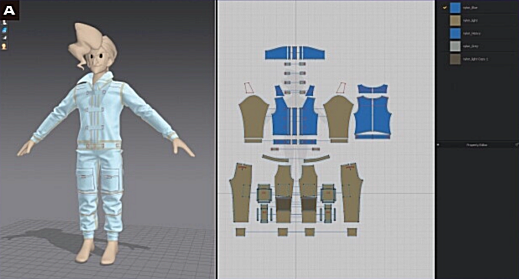 |
| Clothing
being created in MarvelousDesigner |
| Shotgun |
Used
mainly to manage the work between OLM Digital (Japan) and Sprite
Animation (US). Once the storyboards are completed a list of required
elements would be registered into Shotgun to help the teams on both
sides of
the Pacific keep track of the tasks that still needed to be completed.
Shotgun
allows
the staff to import work performed with Maya, Houdini, Nuke, etc. The
two directors and other supervising staff could mark jobs as "Approved"
in the software to let everyone
know that they're OK to proceed to the next task. |
| Maya |
CG
production. OLM-Digital also made use of the Arnold
renderer plug-in. Maya was also used to provide lighting. |
| Houdini |
CG
production. The special effects in the film (Pikachu's
electric attacks, the tears that bring Satoshi back, etc) were
primarily created using Houdini. |
| Nuke |
CG
production. Used for composite work. Employs OpenColorIO
to provide compatibility with ACES (see below). |
| ACES | Stands
for Academy Color Encoding System. Used for color
management. |
| Substance
Painter |
Provided
textures and shading. |
| MarvelousDesigner |
Used
to render the clothing the characters wear. |
| OLM-Digital's
eye shader |
Proprietary
tool used to render characters' eyes. |
| CFTool |
OLM's
in-house tool for managing simulation assets. |
| XGen |
Used
to render hair and fur. |
| OLM
Secondary Motion |
OLM's
in-house tool for managing the little nuanced motions based on a
character's weight, musculature, flexibility, etc. that most people
probably wouldn't notice unless they were missing. |
| FXLinker |
An
original tool used to connect the outputs made in Maya, Houdini, and
Nuke. Effects director Osamu Karasawa is quoted as saying "We couldn't have
finished (this movie) on time if it weren't for FXLinker." |
 |
| OLM's
Secondary Motion tool, with text translated into English. Click on the image for a larger version. |
The staff was composed of over 200 members, or 250 if you include upper management (You can see a complete list of those staff members here).
There were a total of 208 CG models made for this film. Out of those, 109 of them have hair / fur. For comparison's sake, the previous collaboration between OLM Digital and Sprite Animation, a Japan-only (as of this writing) film called Rudolf the Black Cat, only featured 21 models.
There were about two or three people assigned to each character model and it took them an average of 25 days to complete each one.
One of the challengers the animation team faced was what to do with Takeshi's eyes. In the TV series the animators get to just draw two lines and call it a day but that kind of thing wasn't going to work with a CG film; rendering them as simple lines might work for the wide shots but ended up looking really unsettling in the close-ups. After a lot of trial and error they settled on recreating the "closed eyes look" by interpreting those black spaces as clusters of eyelashes. The eyelashes were placed in the same places where real people's eyelashes grow to make them look more natural.
 |
Pikachu was the toughest character for the production staff to get right. The first model they made looked fine when it was standing on two legs but then when they reposed it to have it run on all fours they found that its neck stuck out too much and ruined the classic Pikachu silhouette. You can see that "Before" image below. In order to avoid having to create multiple Pikachu models, the animation team worked on fine tuning the position of the head, the muscles around its neck, etc. until they could get a model that looks like what you see on the right.
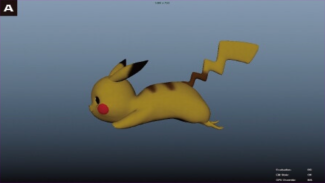 |
 |
| When
Pikachu was put on all fours an awkward looking dent appeared at the
back of its
neck (left). The model had to be tweaked and adjusted to preserve the classic Pikachu silhouette (right). |
|
Speaking of Pikachu, a lot of care was taken to make sure it always looked "cute," so much so that the animation teams even held special meetings just to talk about the Electric Mouse pokemon. The animators gave Pikachu its own digital diva ring light, just like they would if this was a live action film, to help ensure that it always looked bright and cheery. In the end about seven different lighting setups were devised just for Pikachu.
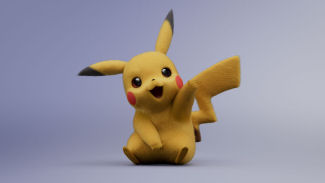 |
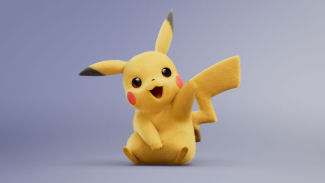 |
| Left:
Pikachu before its diva ring light was added, Right: Pikachu after |
|
Veteran animators from the TV series were brought in to give their feedback on the Pikachu model used in the film.
Special attention was even paid to the light reflected in each character's eyes. Certain characters - the humans, Nyarth, Mewtwo, and Mew - had the highlights in their eyes change along with their head movements. For everyone else the reflections were either stuck in a fixed position or altered depending on the lighting of a particular scene.
Realism was important to the production staff and so efforts were made to keep things as grounded in reality as possible. During the storm scenes in the first half of the film, for example, the size of the waves in the ocean were constantly being adjusted until the staff felt they were high enough to be able to realistically capsize a boat the size of the one our heroes were riding on. Simulations were also done to make sure the boat rode those waves in a realistic manner.
That long single cut of the camera zipping around as the copies and the originals fought each other was an extraordinarily complicated scene to work on. A special meeting was had just for that one cut alone.
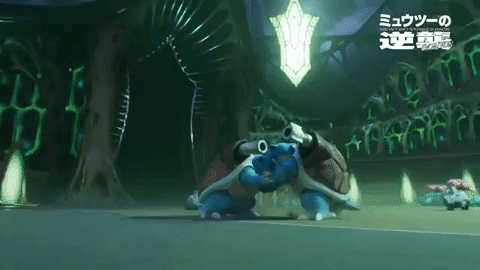 |
| A (very
tiny!) clip of said long cut. The actual cut in the scene is probably
closer to about 30 seconds long as is hands down the most impressive
shot in the film. |
Mewtwo Strikes Back Evolution has 1,168 shots altogether. Spread across those shots was about 1,850 different tasks (special effects elements, for example) for the animators to perform.
More information about this issue of CGWORLD, including links of where to buy the print version for yourself, can be found here. A digital copy is probably more practical for the majority of this site's readers so a link to purchase a digital copy through CGWORLD's app can be found here.
Found an error? Spot an omission? Please help me keep this page current and error-free by e-mailing me with a description of the error or omission.

